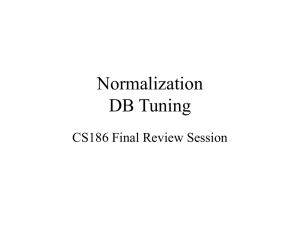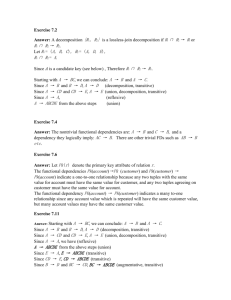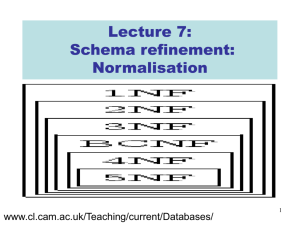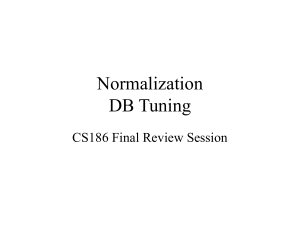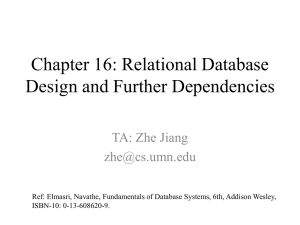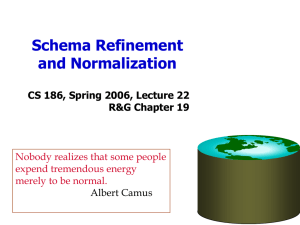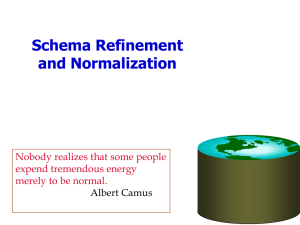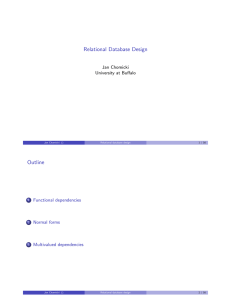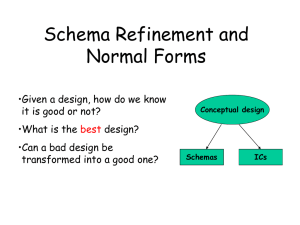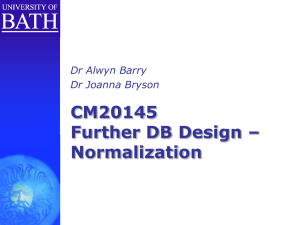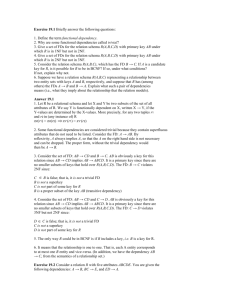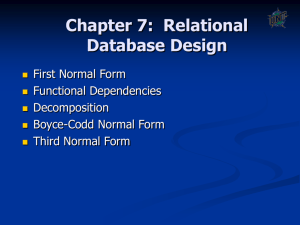notes
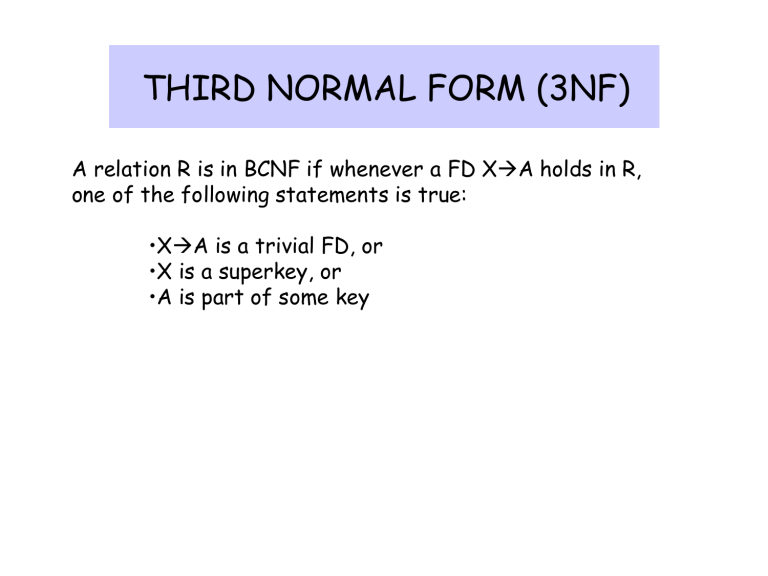
THIRD NORMAL FORM (3NF)
A relation R is in BCNF if whenever a FD X A holds in R, one of the following statements is true:
•X A is a trivial FD, or
•X is a superkey, or
•A is part of some key
Why 3NF?
A relation R is in 3NF if whenever a FD X A holds in R, one of the following statements is true:
•X A is a trivial FD, or
•X is a superkey, or
•A is part of some key
By making an exception for certain dependencies involving some key attributes, we can ensure that every relation schema can be decomposed into a collection of 3NF with two desirable properties: lossless-join and dependency-preserving .
Cases of 3NF Violation
If X Y causes a violation of 3NF, there are two cases:
•X is a proper subset of some key (partial dependency)
KEY Attributes X Attribute Y
Partial dependency causes data redundancy: Since X Y and X is not a key, X could be redundant, so Y.
•X is not a proper subset of any key (transitive dependency)
KEY Attributes X Attribute Y
KEY
Attributes X
Attribute Y
Transitive dependency K X Y makes it impossible to record the values of
(K, X, Y) unless all of them are known: Since K X Y, we cannot associate an
X value with a K value unless we also associate an X value with Y value
Dependency-Preserving Decomposition
Inputs: A relation R with a set Fmin of FDs that is minimum cover
D(R1, R2, …, Rn) is a lossless-join decomposition of R
1. Find all dependencies in Fmin that are not preserved
2. For each such dependency X A, create a relation schema
XA and add it to the decomposition of R
• Every dependency in Fmin is now preserved
Proof: XA is in 3 rd NF
1. X must be a key for XA, Since X A is in a minimal cover, Y A does not hold for any Y that is a subset of X
2. For any other dependencies hold over XA, say Y Z, in Fmin, it must satisfy 3 rd NF conditions
• If Z is A, Y must be X
• If Z is not A, Z must be part of X
Top-Down Approach: Lossless-Join and Dependency
Preserving Decomposition into 3NF
A. Lossless-Join Decomposition
1. Set D {R}
2. While there is a relation schema Q in D that is not in BCNF do begin
• Choose a relation schema Q in D that is not in BCNF; end;
• Find a functional dependency X Y in Q that violates BCNF;
• Replace Q in D by two schemas (Q-Y) and (XUY)
B. Dependency-Preserving Decomposition
1. Assume the decomposition is D(R1, R2, …, Rn) and the FD sets are accordingly F1, F2, …, and Fn (let their union be F’)
2. For each dependency X A in the original F (needs to be a
minimum cover), check if it can be inferred from F’
• If not, create a relation schema XA and add it to the decomposition of R
Exercise
R(ABCDE)
F={ABCD
E,E
D,A
B,AC
D}
Top-down approach
1.
Loss-less join decomposition: R(ACBDE) is not in BCNF
E D
R1(ACE)
R1(ACBE)
A B
R2(AB)
R2(ED)
3. Dependency-preserving decomposition:
{ABCD E, E D, AB B, AC D} + == {AC E, A B, E D} + ??
/* Find a minimum cover first */
/* If X
Y is not preserved, add (XY) into the decomposition */
Bottom-up Approach: Lossless-Join and Dependency
Preserving Decomposition into 3NF
Inputs: A relation R and a set of functional dependencies F on the attributes of R.
1. Find a minimal cover G of F.
2. For each left-hand side X of a FD G, create a relation schema in D with attributes where X A
1
, X A
2
, …, X A m
{ X
in G with X as the left-hand side.
A
1
A
A
3
A are the only dependencies
• Prove that this relation is in 3 rd NF
2
...
m
}
3. If none of the relation schemas in D contains a key of R, then create one more relation schema in D that contains attributes that form a key of R.
• Prove that this decomposition is lossless-join
Exercise
R(ABCDE)
F={ABCD
E,E
D,A
B,AC
D}
Bottom up approach (Synthesis):
Step 1: Find a minimum cover, G={AC E,E D,A B}
Step 2: R1(ACE), R2(ED), R3(AB)
Step 3: Is this a lossless-join decomposition?
Conceptual design
Schemas
Normalization Review
ICs
1. Functional Dependency a) Amstrong’s axioms b) Attribute closure (A+) c) Dependency closure (F+) d) Minimum cover (Fmin)
2. Normal Forms a) BCNF b) 3NF
3. Decomposition a) Lossless join b) Dependency preserving
Determine Normal Forms
1) BCNF
– For each X
A, is it a trivial dependency?
– Is X a superkey?
2) 3NF
– Suppose X
A violate BCNF
– Is A part of some key?
Exercise 1
For each of the following relation schemas and sets of FDs
1. R(ABCD) with FDs AB C, C D, and D A
2. R(ABCD) with FDs B C and B D.
3. R(ABCD) with FDs AB
C, BC
D, CD
A, and
AD B
Check if they are in BCNF or 3NF, if not, perform a lossless join and dependency preserving decomposition
1) BCNF
– For each X A, is it a trivial dependency?
– Is X a superkey?
2) 3NF
– Suppose X
A violate BCNF
– Is A part of some key?
Exercise 2
• Prove that, if R is in 3NF and every key is simple
(i.e, a single attribute), then R is in BCNF
• Prove that, if R has only one key, it is in BCNF if and only if it is in 3NF.
Quiz
1. For each of the following relation schemas Indicate the strongest normal form of each of the following relations
– R1(ABCDE) F1={A B, C D, ACE ABCDE}
– R2(ABCEF) F2={AB C, B F, F E}
2. Consider a relation R with five attributes: ABCDE.
F={A
B, BC
E, ED
A}
– Are {ECD}, {ACD}, {BCD} keys for R?
– Is R in BCNF? Why?
– Is R in 3NF? Why?
Conceptual Schema ( ER diagram )
DBMS independent
DBMS specific
Data Model Mapping
Conceptual Schema ( Relations )
Normalization • BCNF/3NF?
• Decomposition
- Lossless join
- Dependency preservation
